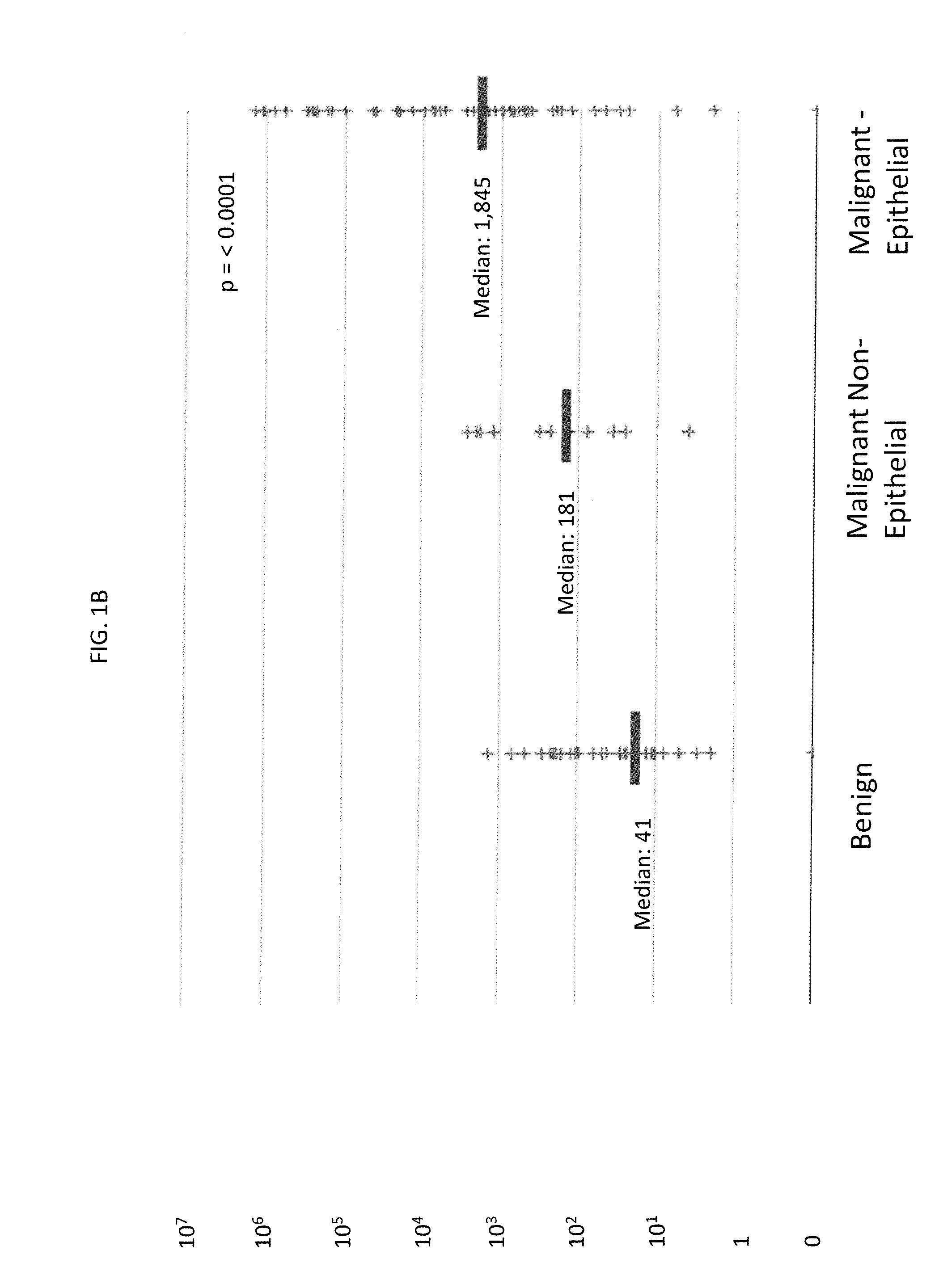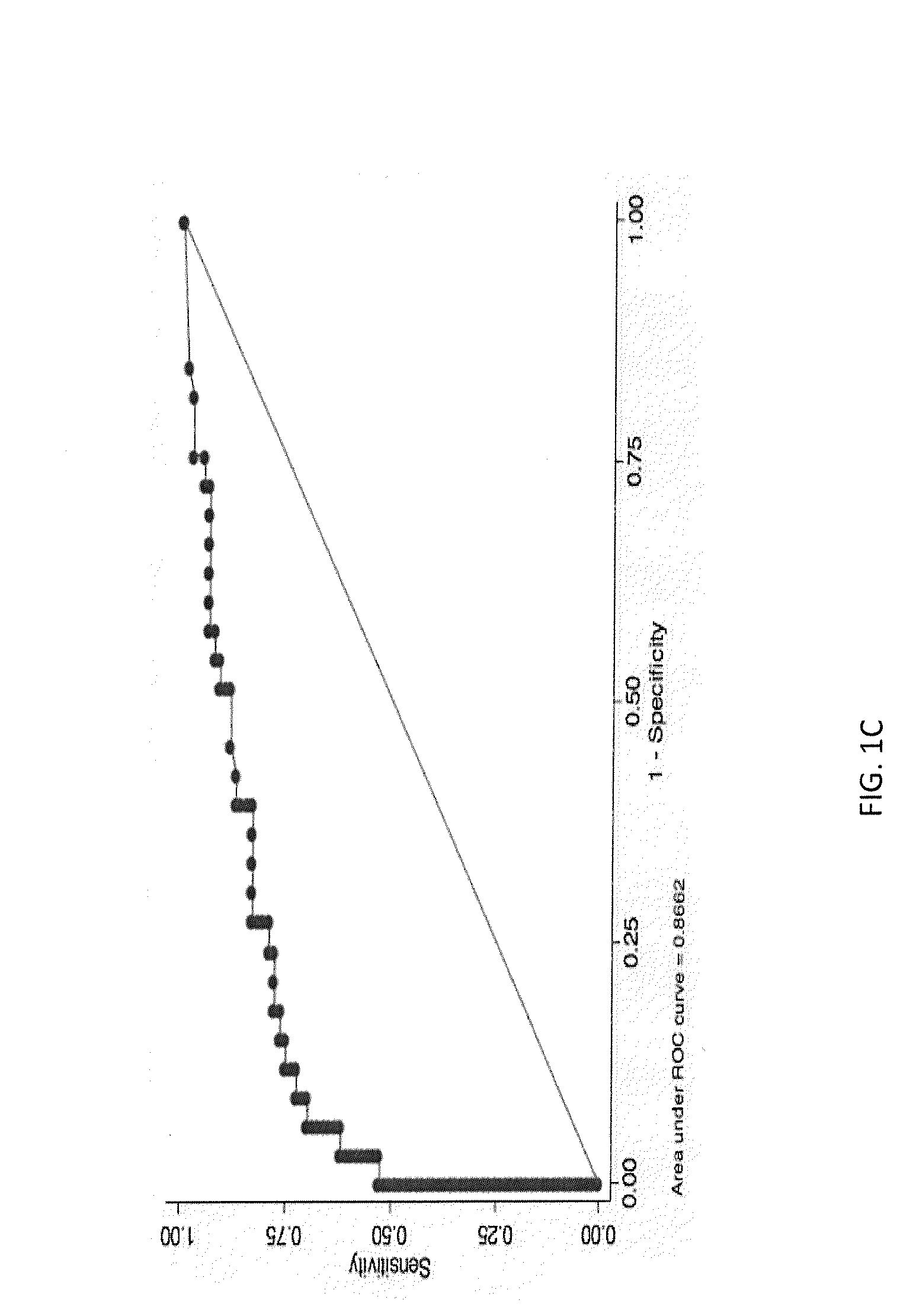Methods for Diagnosing Cancer by Characterization of Tumor Cells Associated with Pleural or Serous Fluids
a pleural or serous fluid and tumor cell technology, applied in the direction of material analysis, biochemistry apparatus and processes, instruments, etc., can solve the problem of inability to definitively cytological and symptomological diagnose a pleural effusion, abnormal collection of fluid, accumulation of fluid, etc., to achieve the effect of increasing diagnostic sensitivity and accuracy
- Summary
- Abstract
- Description
- Claims
- Application Information
AI Technical Summary
Benefits of technology
Problems solved by technology
Method used
Image
Examples
example 1
Pleural Fluid Sample
I. Collection
[0089]Pleural Fluid is usually collected in a sterile 50 cc syringe or sterile urine collection container for cytological examination and can be further treated as in steps II and III, if it is intended to be stored or shipped before being examined by cytological methods as in Example 2.
[0090]For the CellSearch assay of Example 3, unprocessed pleural fluid is withdrawn, as described above. The unprocessed fluid, optionally simply diluted 1:10 with sterile buffer, is transferred to a CellSave® tube.
[0091]The collected fluid in either instance is labeled with sample number and diagnosis, if any. Optimally, fluid is forwarded to the laboratory for processing within 30 minutes of being drawn. All procedures should be done sterilely in the biosafety hood. The pleural fluid samples are subject to the assay of Example 3 within 24 hours.
II. Optional Centrifugation Steps and Supernatant Harvesting for Cytological Examination or Storage Prior to the Method of ...
example 2
Cytologic Examination
I. Preparing the Samples
[0109]A. Centrifuge the remaining cell suspension from Example 1, step III, subparagraph I, at 1500 rpm for another 5 minutes.
[0110]B. Remove the supernatant and prepare to add freezing media.
[0111]C. Re-suspend the pellet in 4 cc of freezing media.
[0112]D. Labels should contain sample number, sample collection date, and an indication that the sample is pleural fluid.
[0113]E. Store in a Nalgene “Mr. Frosty” freezing container containing isopropanol overnight at −80° C. Transfer cryotubes to −140° C. at that time.
II. Cytological Analysis Using a CytoSpin® Apparatus
[0114]A. Transfer 2×106 cells into 4 ml of PBS (with 0.5% FBS).
[0115]B. Pre-label the slides.
[0116]C. Prepare the slides mounted with the paper pad and the cuvette in the metal holder.
[0117]D. Load up to 200 μl of this suspension in each cuvette.
[0118]E. Spin at 750 rpm for 10 min.
[0119]F. Carefully detach the cuvette and the paper without damaging the fresh cytospin.
[0120]G. Mar...
example 3
Assay Using the CellSearch® System
[0123]The CellSearch® Circulating Tumor Cell system (Veridex LLC) is used to identify and enumerate the number of circulating tumor cells in a pleural fluid. The assay procedure is as described in Mayo Medical Laboratories Communique, Volume 36, No. 1 (Jan / February 2011), incorporated by reference herein, and summarized briefly below.
[0124]A. 7.5 ml of unprocessed and undiluted pleural fluid is placed in a CellSave tube (Veridex LLC).
[0125]B. The PBS is removed, and the cellular component is mixed with new buffer to a desired dilution, and then ferrofluid is added. The ferrofluid consists of nanoparticles with a magnetic core surrounded by a polymeric layer coated with antibodies targeting the Epithelial Cell Adhesion Molecule (EpCAM). The ferrofluid / antibody complex attaches specifically to epithelial cells in the cellular component.
[0126]C. The tube containing the ferrofluid / antibody complex is incubated in a magnetic cuvette, which attracts the f...
PUM
| Property | Measurement | Unit |
|---|---|---|
| temperature | aaaaa | aaaaa |
| volume | aaaaa | aaaaa |
| volume | aaaaa | aaaaa |
Abstract
Description
Claims
Application Information
 Login to View More
Login to View More - R&D
- Intellectual Property
- Life Sciences
- Materials
- Tech Scout
- Unparalleled Data Quality
- Higher Quality Content
- 60% Fewer Hallucinations
Browse by: Latest US Patents, China's latest patents, Technical Efficacy Thesaurus, Application Domain, Technology Topic, Popular Technical Reports.
© 2025 PatSnap. All rights reserved.Legal|Privacy policy|Modern Slavery Act Transparency Statement|Sitemap|About US| Contact US: help@patsnap.com



